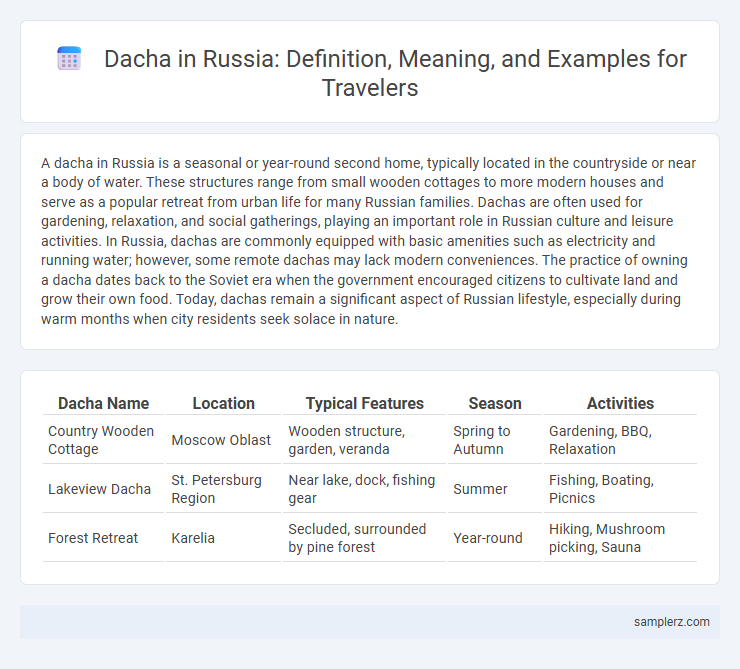A dacha in Russia is a seasonal or year-round second home, typically located in the countryside or near a body of water. These structures range from small wooden cottages to more modern houses and serve as a popular retreat from urban life for many Russian families. Dachas are often used for gardening, relaxation, and social gatherings, playing an important role in Russian culture and leisure activities. In Russia, dachas are commonly equipped with basic amenities such as electricity and running water; however, some remote dachas may lack modern conveniences. The practice of owning a dacha dates back to the Soviet era when the government encouraged citizens to cultivate land and grow their own food. Today, dachas remain a significant aspect of Russian lifestyle, especially during warm months when city residents seek solace in nature.
Table of Comparison
| Dacha Name | Location | Typical Features | Season | Activities |
|---|---|---|---|---|
| Country Wooden Cottage | Moscow Oblast | Wooden structure, garden, veranda | Spring to Autumn | Gardening, BBQ, Relaxation |
| Lakeview Dacha | St. Petersburg Region | Near lake, dock, fishing gear | Summer | Fishing, Boating, Picnics |
| Forest Retreat | Karelia | Secluded, surrounded by pine forest | Year-round | Hiking, Mushroom picking, Sauna |
Introduction to Dacha: Russia’s Beloved Countryside Retreat
A dacha in Russia serves as a cherished countryside retreat, often a seasonal second home featuring a garden and modest cottage. These properties embody traditional Russian leisure, allowing families to engage in gardening, relaxation, and escape from urban environments. Dachas are deeply ingrained in Russian culture, reflecting a unique blend of simplicity, nature, and communal heritage.
Historical Roots of the Russian Dacha Tradition
The Russian dacha tradition dates back to the 17th century when tsars granted land plots to nobles as summer retreats, fostering a culture of countryside escape. By the 19th century, dachas became popular among the Russian middle class, symbolizing a connection to nature and relaxation outside urban centers like Moscow and Saint Petersburg. These historical roots highlight the dacha's role as a cultural emblem reflecting Russian social changes and a preference for seasonal rural life.
Typical Architectural Features of a Russian Dacha
Russian dachas typically feature wooden construction with intricate carvings on window frames and eaves, reflecting traditional folk art. These country houses often have steep, gabled roofs designed for heavy snow, alongside spacious verandas that offer panoramic views of surrounding gardens. Brightly painted exteriors with contrasting trims and small, decorative shutters highlight the architectural charm unique to rural Russia.
Popular Regions for Dacha Ownership in Russia
Popular regions for dacha ownership in Russia include the Moscow Oblast, known for its proximity to the capital and scenic forests, and the Leningrad Oblast surrounding Saint Petersburg, which offers lakefront retreats. The Tver and Vladimir regions are favored for their peaceful rural landscapes and historical sites, attracting urban residents seeking relaxation. Coastal areas near the Black Sea, such as Sochi, also provide dachas with mild climates and recreational opportunities, enhancing their appeal for seasonal escapes.
Seasonal Activities at a Russian Dacha
At a Russian dacha, seasonal activities vary widely, from planting vegetables and flowers in spring and summer to berry and mushroom picking in forests nearby during late summer and early autumn. Winter transforms the dacha experience with ice skating on frozen ponds and cozying up by the traditional Russian stove, known as a "pech'," while enjoying homemade preserves. These activities highlight the cultural connection to nature and the rhythm of rural Russian life throughout the year.
Gardening and Self-Sufficiency at the Dacha
Russian dachas are traditional country homes often surrounded by vibrant gardens where owners cultivate vegetables, fruits, and herbs to ensure fresh, self-sufficient produce. Gardening at the dacha emphasizes sustainable practices, including composting and crop rotation, to maintain soil fertility and maximize yield. This lifestyle promotes a close connection to nature while reducing dependence on commercial food sources.
The Social Aspect: Family and Community at the Dacha
At Russian dachas, social interactions play a vital role in strengthening family bonds and fostering community spirit. These seasonal cottages serve as gathering places where relatives and neighbors share gardening tasks, cook traditional meals, and celebrate holidays together. This communal lifestyle at the dacha promotes intergenerational connections and a deep sense of belonging.
Interior Design and Decor Styles in Russian Dachas
Russian dachas often showcase a blend of traditional and rustic interior design styles, featuring wooden log walls, handcrafted furniture, and floral textiles that reflect country charm. Elements like embroidered linens, samovars, and vintage ceramics add cultural authenticity and warmth to the space. Bright colors, folk art motifs, and open fireplaces create a cozy ambiance characteristic of Russian countryside retreats.
Dacha as a Second Home: Legal and Economic Considerations
Dachas in Russia function as popular second homes, offering urban residents a retreat while maintaining property rights distinct from primary residences. Legal considerations include land ownership regulations under Russian federal law, requiring compliance with zoning rules and registration with local authorities to ensure proper documentation. Economically, dachas contribute to rural property markets and seasonal tourism, impacting local economies through maintenance costs, property taxes, and increased demand for regional goods and services.
The Cultural Significance of Dacha Life in Modern Russia
Dachas in Russia represent more than just seasonal homes; they embody a cultural tradition deeply rooted in Russian history and lifestyle. These countryside retreats serve as vital spaces for family bonding, relaxation, and reconnecting with nature, reflecting the enduring values of simplicity and community. Modern dacha life continues to influence Russian social practices, symbolizing a harmonious balance between urban living and pastoral heritage.

example of dacha in Russia Infographic
 samplerz.com
samplerz.com